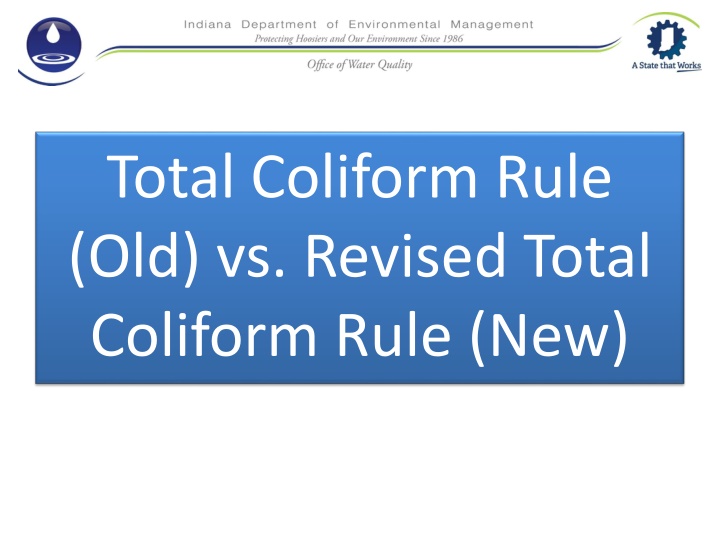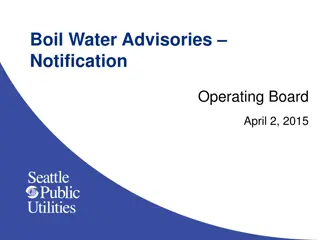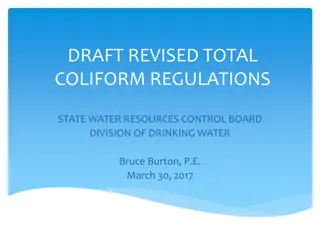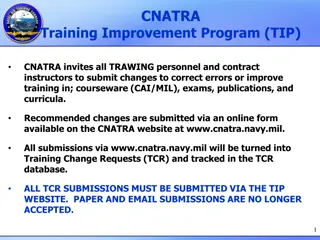
Revised Total Coliform Rule Amendments and Monitoring Procedures
The Revised Total Coliform Rule (RTCR) introduces updated guidelines for monitoring water quality, including sampling plans, routine monitoring requirements, repeat sampling protocols, and assessment triggers. Systems must adhere to revised procedures to ensure the safety of public water supplies and comply with regulatory standards. The amendments aim to enhance the monitoring of total coliform levels and react promptly to potential contamination risks.
Download Presentation

Please find below an Image/Link to download the presentation.
The content on the website is provided AS IS for your information and personal use only. It may not be sold, licensed, or shared on other websites without obtaining consent from the author. If you encounter any issues during the download, it is possible that the publisher has removed the file from their server.
You are allowed to download the files provided on this website for personal or commercial use, subject to the condition that they are used lawfully. All files are the property of their respective owners.
The content on the website is provided AS IS for your information and personal use only. It may not be sold, licensed, or shared on other websites without obtaining consent from the author.
E N D
Presentation Transcript
Total Coliform Rule (Old) vs. Revised Total Coliform Rule (New)
Abbreviations To Know RTCR Revised Total Coliform Rule TCR Total Coliform Rule TC Total Coliform EC E. coli PN Public Notice CCR Consumer Confidence Report PWS Public Water Supply TT Treatment Technique MCL Maximum Contaminant Level
Sampling Plan TCR RTCR System must collect samples that are representative of water throughout the distribution system and the monitoring period according to a written sample siting plan. * Systems must develop a written site sampling plan that identifies sampling sites and sample collection schedule that are representative of water throughout the distribution system, no later than March 31, 2016. * Sites may include a customer s premise or dedicated sampling station. * Routine, repeat and ground water rule sampling sites must be reflected in the plan. Plans are subject to IDEM review, approval & revision request
Additional Routine Monitoring TCR RTCR PWS taking < 5 routine samples per month (PWS serving 4,100): * Must take at least 5 routine samples in the month after a TC+ sample. No longer a requirement for systems that monitor at least monthly. PWSS taking samples less frequently than once per month (i.e. quarterly): *Must take at least 3 routine samples in a month after a TC+ sample.
Repeat Monitoring # of Samples TCR RTCR All PWS must take 3 repeat samples for every TC+ routine sample PWS serving 1,000: 4 repeat samples for every TC+ routine sample. PWS serving >1,000: 3 repeat samples for every TC+ routine sample. Must take additional repeats for TC+ until trigger an MCL violation. Must take additional repeats until the PWS triggers an assessment or has a set of repeat samples that are all TC-
Repeat Monitoring - Locations TCR RTCR Repeat samples must be collected from the original TC+ site, at least one at a tap within 5 service connections upstream, and at least one at a tap within 5 service connections downstream. PWS can collect repeat samples using the same procedures as in TCR; or based on site-specific conditions, the PWS may sample at alternative representative sites with permission from IDEM.
TT Triggers & Level 1 & 2 Assessments TCR RTCR Does not exist All systems required to conduct Level1/Level 2 assessment when monitoring results show that the system may be vulnerable to contamination. - Initiated by a TT triggers, it is an evaluation to identify sanitary defects. - Conditions that defined a non-acute MCL violation under TCR are now used to trigger an assessment. - More proactive approach to public health protection compared to TCR.
MCL Violations TCR RTCR Routine sample Repeat sample AND Fecal coliform positive repeat sample TC+ EC+ EC+ EC+ TC+ TC+ repeat sample following a fecal coliform positive or EC+ routing sample EC+ routine Fails to take all required repeat samples TC+ (but no E. coli analyzed) TC+
TT Violations TCR RTCR Does not exist TT Violations: - Failure to conduct a level 1 or Level 2 assessment within 30 days of learning of the trigger. - Failure to correct all sanitary defects from a Level 1 or Level 2 assessment within 30 days of learning of the trigger or approved timeframe by IDEM.
Monitoring & Reporting Violations (M&R) TCR RTCR M&R violation (tracked together as 1 violation type) Monitoring violations and reporting violations will be tracked separately as two different violation types Newly specified Monitoring, Reporting violations: Monitoring - Failure to take every required routine or additional routine sample in a compliance period. Monitoring - Failure to analyze for E. coli following a TC+ routine sample. Reporting - Failure to submit a monitoring report or completed assessment form after monitoring or conducting assessment correctly/timely. Reporting - Failure to notify the state following an E. coli+ sample.
PN for MCL & TT Violations TCR RTCR TC MCL violation/acute MCL: FC+ or E.coli + E. coli MCL violations Tier 1 Monthly TC MCL violation Treatment technique (TT) violations Tier 2 M&R (tracked as 1 violation type) Monitoring Tier 3 M&R (tracked as 1 violation type) Reporting Tier 3
PN & CCR Rules-Health Effects Language TC RTCR Mandatory health effects language for total coliforms and fecal coliforms/E. coli. Total coliforms health effects language changed to reflect nature of total coliforms as an indicator. The health effects language for fecal coliforms/E. coli has been replaced with health effects language for E. coli only.
CCR Language TCR RTCR Information related to highest monthly total coliforms results (number or percentage) and the total number of fecal coliforms/E. coli-positive samples. Information on the total number of E. coli-positive samples. Information about the number of assessments required and corrective actions taken, and, if appropriate, the number of assessments and corrective actions not completed.





